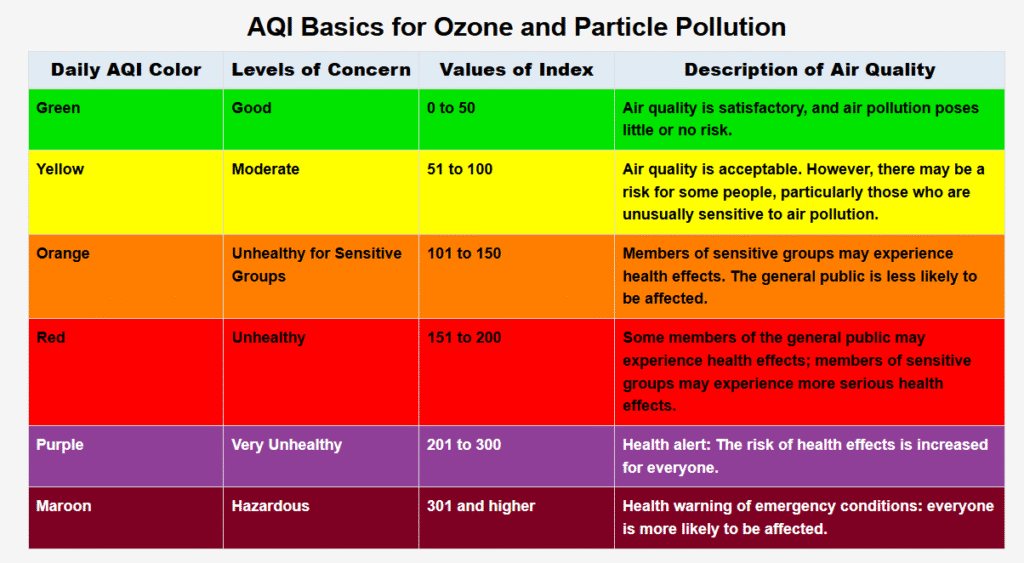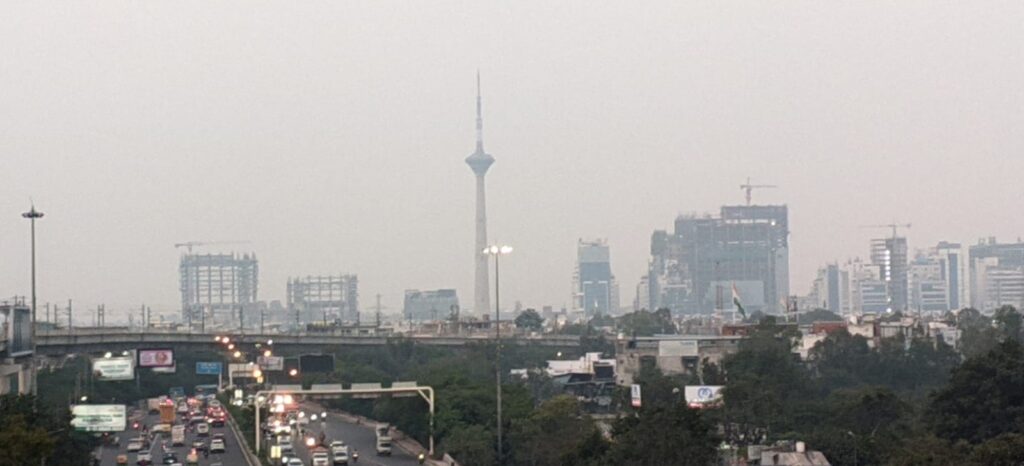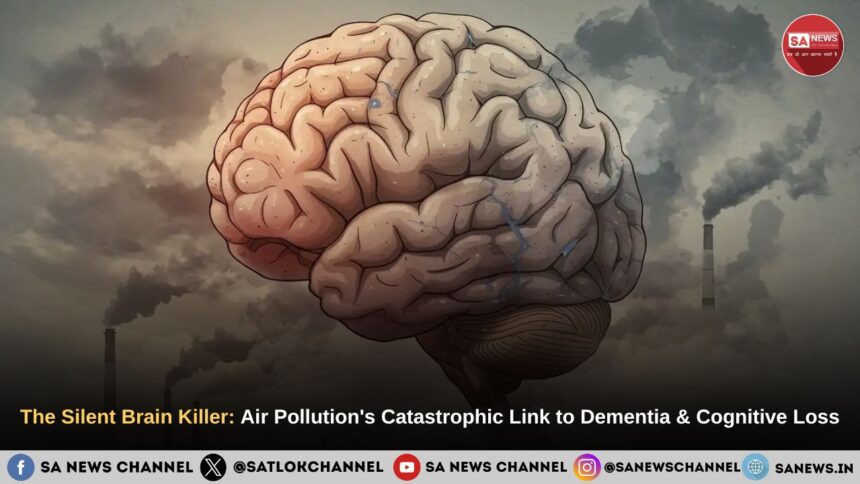Air Pollution: Did you know that 15% of all deaths in Delhi are linked to air pollution? As you read this, there are children in the capital whose lungs resemble those of long term smokers, simply because they are breathing the city’s air. And now imagine newborns inhaling that very same air from their first day of life.
- Understanding the Air Quality Standards
- An Alarming Crisis: Adverse Effects of Bad Air Quality
- When the Air Turns Toxic: Life in Delhi
- Delhi’s Geographical Structure: The Trapped Bowl
- Lessons from Beijing’s Clean Air War
- The Contrast in the Capital
- A Wake-Up Call
- Thinking Beyond this Asymmetrical World
- FAQs
In this article, we’ll uncover why pollution shouldn’t be taken lightly and why it’s not just an environmental concern but a catastrophic public health crisis contributing to cognitive decline and even early-onset dementia in the younger generation. Along the way, we’ll also break down a few eye-opening case studies.
Understanding the Air Quality Standards
Before we dive deeper, let’s take a look at the Air Quality Metrics set by the World Health Organization

(Source: EPA’s Standards)
As it’s evident, the higher the value, the more risk it carries and anything above 300 is extremely hazardous, leading to severe symptoms.
Now, you may wonder what even determines this AQI value? There are five major pollutants considered when calculating the AQI, and each of these pollutants have a standard set by the WHO to protect the public health.
- Particle Pollution [PM2.5 Recommended Level: 5 μg/m³; PM10: 15 μg/m³ (Annual Mean)]
- Ground Level Ozone (Recommended Level: 60)
- Carbon Monoxide (Recommended Level: 4)
- Sulfur Dioxide (Recommended Level: 40)
- Nitrogen Dioxide (Recommended Level: 10)
(Source: Detailed Guidelines by WHO, 2021)
That said, WHO updated its guidelines in 2021, revising the earlier 2005 standards, as new epidemiological evidence revealed harm at much lower pollution levels.
To make matters worse, studies show that pollution levels long thought to be safe can increase the risk of health problems, including those affecting the brain.
An Alarming Crisis: Adverse Effects of Bad Air Quality
Research by the Keck School of Medicine has shown that even pollutants at levels previously considered relatively low are linked to changes in brain function over time, so one can imagine the adverse effects when pollutant levels skyrocket. Let’s dive deeper into this:
How Air Pollution Quietly Rewires the Developing Brain
The researchers at Keck School revealed that children who were exposed to relatively more pollutants (within the safe–moderate standards) showed abnormal changes in connectivity in many regions of the brain. In some areas, they had more connections than normal, while in other areas, they had fewer.
(Source: Keck School of Medicine)
The brain is one of the body’s most vital organs, and this deviation in neural connections can be very harmful down the lane.
Poor air quality shouldn’t be taken lightly. Exposure to pollutants in the long run can have very severe consequences. Pollution is linked with neurodevelopmental delays, as well as longitudinal changes in brain network development.
But unfortunately, the trail of tragedies doesn’t stop here. There have been studies indicating that pollutants can trigger devastating forms of dementia by forming toxic clumps of proteins that destroy nerve cells as they spread through the brain.
Lewy Body Dementia
The researchers also found that prolonged exposure to PM2.5 linked to an increased risk of Lewy Body Dementia, which is a brain disorder leading to a decline in thinking, movement, mood and overall behaviour.
Broadly speaking, all these studies underscore the urgent need to understand the impact of air pollution which isn’t just harming our lungs but affecting the growth of our brain itself!
Links to Cognitive Decline
Dr. Edward Lee, a neuropathologist who conducted research which showed that the quality of air you live in affects your cognition.
Simply said, the more polluted air you breathe, the more prone you are to a cognitive decline and reduced psychomotor development in children which controls their physical coordination and psychological (mental and emotional) abilities.
Eventually, this brings us to a very alarming case unfolding in the Indian capital, Delhi, often known as ‘dil walo ki Delhi,’ though perhaps it’s time we rethink that.
When the Air Turns Toxic: Life in Delhi
Statistics from 2019 show that 1 lakh children under the age of 5 die every year due to pollution in Delhi, and that was roughly six years ago and the pollution has only gotten worse since then. (Source: IndiaToday)
Meanwhile, those who actually make it through are likely to have suffered through a cognitive decline, health problems, and perform badly in school just for breathing.
“Our study highlights the need for detailed research on particulate-matter sources and chemical components crucial for understanding long-term neurocognitive effects.”
(Dr Megan Herting, Keck School of Medicine from India Today, Nov 2024)
These PM2.5 particles are way smaller than what you can possibly imagine. They are 30 times smaller than the width of your hair. But the damage? They go completely undetected by your nose and lungs defense system and seep right into your bloodstream, and there starts the damage to your brain.

Delhi’s AQI recently hit 795 and it’s been averaging just around that in Nov ’25. That’s literally 100 times the safe limits set by WHO. At one point, it even crossed 1700. One can’t fathom the damage being done to the lungs and brains of the younger generations who’re still developing.
But the irony? Despite knowing the harsh consequences, we still let them inhale the very same air, in fact normalizing it as the “winter smog season”.
Just picture this, If air pollution can influence the risk of dementia in relatively cleaner environments of the US, where the studies were conducted. What would be the impact in Delhi which has crossed all the bars? If not controlled, this could put the city’s cognitive future at a grave risk.

(Source: Lung Care Foundation)
It’s not just winters or Delhi but the entirety of India suffering from this, but Delhi’s geographical topography, which makes pollution worse. Now while we’re at it, let’s also take a quick look at Delhi’s geographical condition:
Delhi’s Geographical Structure: The Trapped Bowl
Delhi lies in a semi-enclosed topographical basin-like structure, covered by the walls of the Himalayas and the Aravalli Hills, trapping the air inside with nowhere for it to go. Because of this, every pollutant released in this region gets trapped in the same environment.

Moreover, during summers, the sun heats up the ground, which consequently heats the air above it, making pollutants dissipate as the hot air rises.
But during winters, this gets even worse due to temperature inversion, as the air on the ground becomes much colder than the air higher up in the atmosphere, forming a sandwich-like layer that traps pollutants in a compressed space with nowhere to escape. This eventually leads to much worse air quality, with the concentration of pollutants multiplying by nearly 10x.
Now to make matters worse, we have north-western winds sweeping all the smoke and dust from states like Punjab right into the bowl of Delhi, combined with the massive pollution caused by emissions from motor vehicles and lastly, the most notorious factor being the stubble burning.
But are these factors too severe to be fixed? Not really. Look at the similar case of Beijing, China, which sits in the exact same geographical bowl and once suffered from the exact same crisis. Yet despite all the odds, they acknowledged the problem, declared an all-out war against pollution, and finally achieved clear blue skies in just 10 years. That’s impressive, no?
Lessons from Beijing’s Clean Air War
Let’s briefly look at the five-action decisive plan that was launched in Beijing as a war against pollution in
2013:

• Shut Down Major Polluters: They permanently closed 2,000 factories in Beijing. One of China’s largest steel companies, Shougang, was relocated from Beijing to Hebei province, a move that cost $15 billion and resulted in 80,000 job losses, but was necessary to overcome the crisis.
• Replaced Coal Heating: A massive subsidized program was launched to replace millions of household coal stoves with cleaner electric or gas heaters, with the government covering the majority of the cost.
• Invested in Public Infrastructure: Beijing underwent one of history’s most rapid transit expansions, growing its subway network from two lines (54 km) in 2000 to nearly 1,000 kilometers of track today. They deployed hundreds of thousands of electric buses, providing easy access to public transport. Apart from this, they also planted 54 million trees around the city.
Also Read: The Future Is Electric: How Battery Innovations Are Fueling the EV Boom
• Tackled Agricultural Burning Strategically: Instead of just banning stubble burning, they made it economically disadvantageous. Farmers were offered guaranteed profitable rates to sell crop residue to biomass power plants. Alternatively, they could use heavily subsidized machinery (government covered 80% of the cost) to incorporate stubble into the soil. This strategy resulted in a 70% drop in agricultural fires within just three years.
• Enforced and Monitored Ruthlessly: All steps were monitored and enforced strictly. Satellites tracked fires 24/7, and local officials faced penalties if they failed to extinguish a detected fire within two hours. Furthermore, political incentives were aligned with environmental targets, promotions became tied to air quality improvements, and failure to meet targets could lead to being fired.
And finally, with time, the smog cleared up and the air quality improved drastically. Just like that, Children could once again play freely in the parks, and people could jog around the city without worrying about the air.
Here’s a very detailed article to read more about how Beijing achieved clear blue skies.
The Contrast in the Capital
Meanwhile, the scenes in Delhi are quite surprising, viral reports showed workers spraying water near AQI sensors, hoping they won’t show the city topping the pollution charts, instead of actually tackling the root cause. Crores of tax money have gone down the drain with strategies like cloud seeding, yet here we are.

Large-scale research shows that long-term exposure to air pollution leads to noticeable drops in academic performance and cognitive abilities in children, and it similarly affects the overall performance of adults, eventually reducing productivity.
Children growing up in polluted environments score lower on memory and cognitive assessments. They struggle to maintain focus, fatigue more quickly, and are more likely to miss school altogether. So why not take real measures before it’s too late?
A Wake-Up Call
The damage done to your lungs and brain is completely irreversible, and what’s even more concerning is the impact it will have on the younger generation, whose minds are still developing. Pollution levels in Delhi have exceeded anything the WHO could’ve envisioned, and this is no longer “typical pollution”, it’s a catastrophe affecting the overall development of an entire generation of kids, and everyone else.
How can we expect the coming generation to be innovative and creative when they’re breathing toxins that directly impair their concentration, focus, and both cognitive and physical abilities?
And while the privileged can still buy air purifiers and wear masks outside, what happens to those who can’t afford them? Clean air is a fundamental right, not a luxury. It’s high time people realize this is an emergency and act accordingly.
Thinking Beyond this Asymmetrical World
Reflecting on pollution makes us realize the stark difference between the life of someone born into a highly educated, wealthy household in a first-world country and someone growing up in an economically struggling background in a third-world nation.
At some point, you must’ve wondered about the reason behind this unfairness in the world. Sure, there are many beliefs that try to explain it through ideas like the “karma” of past lives, but does it really make sense to punish someone for memories they don’t even possess? Isn’t that cruel? And if so, doesn’t it suggest that the god of this world may not be as righteous and caring as people claim?
Sant Rampal Ji Maharaj offers a conclusive and elaborative insight to all those questions brimming in your mind, He provides evidence from our very own holy scriptures, and unfolds the true essence of spirituality as mentioned in our holy books.
Do read this detailed article on the creation of the universe which answers all your questions!
FAQs
1. Can Delhi’s polluted air increase my risk of dementia?
Answer: Yes. Long-term exposure to high PM2.5 levels, which are common in Delhi can inflame the brain, disrupt protein regulation, and raise the risk of Alzheimer’s and other dementias.
2. How does PM2.5 physically damage the brain?
Answer: PM2.5 particles enter the lungs, slip into the bloodstream, and reach the brain. There, they trigger chronic inflammation and oxidative stress, damaging neurons, shrinking brain structures, and causing harmful protein buildup linked to dementia.
3. Is “brain fog” on high-pollution days permanent?
Answer: Not always, but it’s a warning sign. Temporary brain fog signals stress on the brain from toxins and low oxygen. Frequent episodes, common during Delhi’s winter smog, can add up and contribute to long-term cognitive decline.
4. Are children and the elderly more vulnerable?
Answer: Yes. Children’s brains are still developing, making them prone to attention and learning issues. Seniors have lower cognitive reserves, so pollution can speed up the transition from mild memory issues to dementia.
5. Can an air purifier protect my brain?
Answer: Yes. HEPA air purifiers reduce indoor PM2.5 exposure and help slow cognitive decline. Pair this with N95 masks outdoors and an antioxidant-rich diet to further limit pollution-related brain damage.









